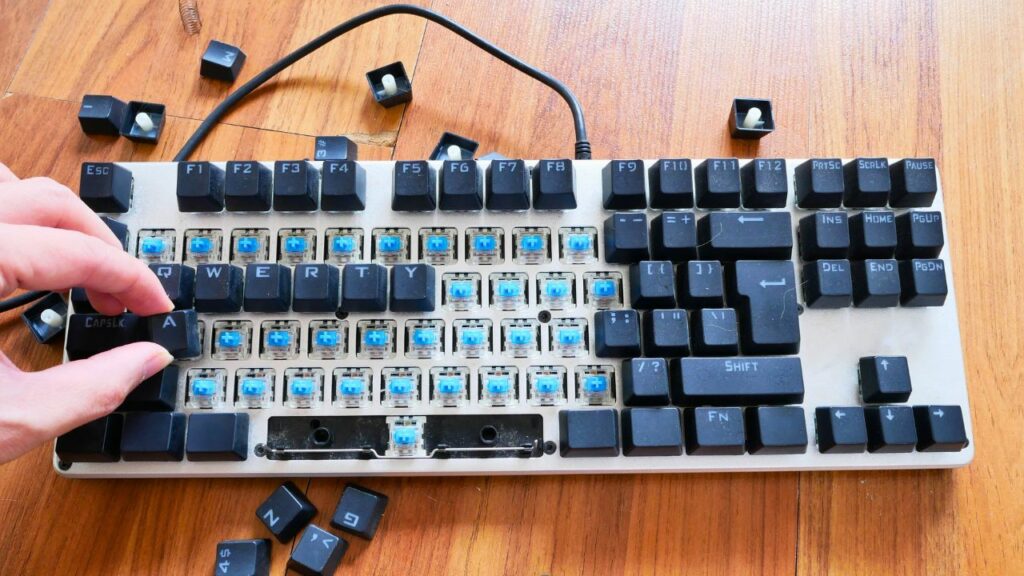
You love your mechanical keyboard, with its satisfying blue switches. Each keypress releases an orchestra of clicks, offering a sense of tactile gratification and auditory delight. But not everyone shares your enthusiasm for this symphony of sounds. Perhaps you work in a shared space, or maybe the click-clack is disrupting your concentration during gaming sessions. Whatever the reason, if you’re looking to make your blue switches quieter, you’re in the right place.
The Magic of O Rings
O rings are small but mighty when it comes to noise reduction. These tiny rubber bands can be slipped onto each keycap stem, creating a cushion that softens the impact when a key is pressed. The result? A significantly less noisy typing experience. You’re welcome, roommates! For more information on how to use O rings on your blue switches, check out this helpful guide.
Dampen the Noise with Foam
Dampening foam isn’t just for soundproofing rooms; it can also help absorb vibrations from your clattering keys. Placed inside the keyboard case, it acts as a kind of sound-absorbing blanket, muffling the cacophony produced by those clicky blue switches.
A Smooth Move: Lubrication
Lubing your switches can reduce friction and noise in one slick move. Using a light lubricant like WD-40 or silicone grease can help make each keystroke smoother and quieter. For an extra bonus, consider investing in pre-lubed switches which come ready to provide a butter-smooth typing experience.
The Power of Quieter Keycaps
Sometimes all it takes is a simple swap to make things quieter. Quieter keycaps are made from materials that inherently dampen sound, reducing the decibel level each time you depress a key.
Beyond Blue: Quieter Switch Options
While we love our blue switches for their crisp tactile feedback and characteristic sound profile, they are not the quietest kids on the block. If you find yourself longing for peace and quiet during your typing sessions or gaming marathons, consider exploring other switch types such as linear switches which offer lower actuation force and don’t have that distinctive click sound.
Feeling a bit adventurous and want to play around with diverse switch types? Consider immersing yourself in the intriguing realm of Frankenstein switches. Or perhaps you’re curious about the face-off between Glorious Panda and Holy Panda.
Understanding the Blue Switches’ Charm
Before we navigate the ins and outs of quieting blue switches, let’s first understand why they’re so vocal. Blue switches are celebrated for their sharp, clicky audio, which springs from the tactile feedback they deliver. This isn’t mere noise – for many typists and gamers, it’s a satisfying confirmation of a successful key actuation. But this distinct sound may not always be music to the ears of those around you.
Choosing the Right O Rings
Not all O rings are created equal. When it comes to dampening sound, the thickness and hardness of your O rings matter. Thicker and softer O rings offer better sound insulation but may alter the keystroke feel more than thinner, harder ones. It’s all about finding the right balance that suits your personal preference and noise reduction needs.
Applying Lubricant Correctly
While lubrication can effectively reduce keyboard noise, applying it correctly is crucial for its success. Over-lubricating can lead to sticky keys, while under-lubricating may not be effective at reducing noise. The goal is to apply a thin layer evenly across each switch component without inundating them.
Considering Other Modifications

Apart from switching keycaps and using O rings or dampening foam, there are other modifications you might consider for making your blue switches quieter. For instance, you could look into using switch films or even desoldering your switches and replacing them with quieter alternatives.
FAQs
Q: Can I make my blue switches as quiet as linear switches?
A: While you can significantly reduce the sound produced by blue switches using methods like O rings, dampening foam, and lubricant, they may not become as quiet as linear switches due to their inherent clicky design.
Q: Will making my blue switches quieter affect their performance?
A: Not necessarily. If done correctly, these modifications should only affect the volume of your typing without impacting performance. In fact, some modifications like lubrication can improve key smoothness.
Q: Does it matter what type of lubricant I use on my keyboard?
A: Yes! Always opt for light lubricants like WD-40 or silicone grease when lubricating your keyboard. Heavy oils or greases could make keys feel sluggish or sticky.
Q: What are some alternatives if these methods aren’t enough to quieten my keyboard?
A: If these modifications aren’t enough to achieve your desired sound level, you might consider switching to a different type of switch that is inherently quieter like linear switches.
Conclusion
Making your blue switches quieter isn’t just about preserving workplace harmony or prolonging late-night gaming sessions without waking up the household—it’s also about enhancing your typing experience by making it smoother and more responsive.
Remember that every modification made to your keyboard should reflect what feels best under your fingertips because at the end of the day, it’s all about creating a setup that suits YOU perfectly.